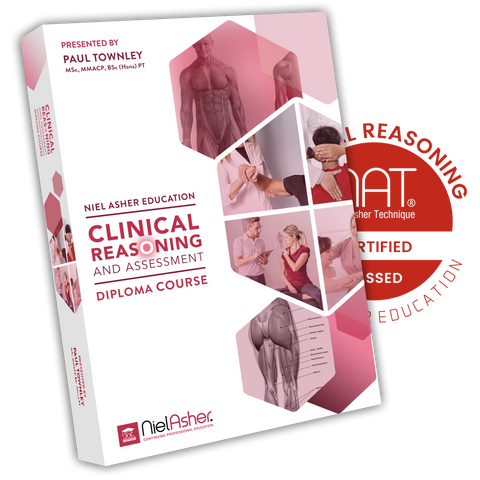Pectoralis Minor | Trigger Point Release Therapy | Anatomy
This thin, flat muscle connects the ribs to the shoulder blade, and can be difficult to palpate, as it is under the Pectoralis major
The Pectoralis minor pulls down the coracoid process, which pulls the shoulder blade forward and down whenever you push, punch, or raise your arm out to the side (abduction) and return it to the starting position (adduction).
Trigger points in the pectoralis minor have a distinct pattern
Tightness in this muscle causes problems when your arm is at shoulder level and you try to reach backward or forward, or forward and up.
Pain at the end of the ROM and restricted ROM are ways this muscle lets you know it’s in trouble. Compensations in this muscle are common causes of thoracic tunnel syndrome, CTS, and frozen shoulder. Blood vessel entrapment by TrPs in this muscle may contribute to some cases of Raynaud’s phenomenon.
Trigger Points
Weakness of the lower trapezius may cause trigger points in the pectoralis minor; these trigger points can entrap nerves and blood vessels.
Trigger points in the scalene, pectoralis minor, and subclavius muscles can cause true TOS.
The last three fingers, or even the whole hand and arm, can become numb or tingly, especially if you are working hunched over, or lying on that side.
Those areas may become cold and stiff after working on the computer for some time. The radial pulse can disappear because of arterial entrapment when the arm is raised into certain positions.
Trigger points in this muscle may cause cardiac arrhythmia, and the referral pattern may be mistaken for angina or heart attack.
A well-aimed stretch and spray often eliminates symptoms immediately if they are trigger points related.
When in doubt, check it out! If hot, prickling jabs of pain are being referred to the pectoralis area, check for scar tissue trigger points in the coracoid attachment area.
Failure to recognize trigger points in this area may needlessly have ended many an athlete’s career, and caused disability in others.
Perpetuating Factors
Paradoxical (shallow) breathing, head-forward posture, poorly fitted or overly heavy backpacks, heart conditions, using poles to pull yourself along when hiking or skiing, or prolonged use of crutches can perpetuate these trigger points, as can nursing an infant, prolonged cuddling of a child or pet in a hunched- over posture, carrying a heavy child, gardening, or sleeping curled up on the side with the lower shoulder forced forward.
Hints for Control
Check breathing and posture, and correct your workstation ergonomics.
Check the pectoralis major, scalenes, SCM, and muscles in other areas for related trigger points.
Even if “cardiac” symptoms provoked by these trigger points are temporarily eliminated by trigger point therapy, if something is perpetuating them, an investigation of possible visceral initiators or any other more serious causes is a must.
Links
More Articles About Shoulder Injuries
More Articles About Trigger Points
Certify as a Trigger Point Therapist

Trigger Point Therapy Diploma Course


Clinical Reasoning and Assessment for Manual Therapists
JOIN NOW
EDUCATION MEMBERSHIP PLANS
UNLIMITED ACCESS
FROM $19.95/monthly
This trigger point therapy blog is intended to be used for information purposes only and is not intended to be used for medical diagnosis or treatment or to substitute for a medical diagnosis and/or treatment rendered or prescribed by a physician or competent healthcare professional. This information is designed as educational material, but should not be taken as a recommendation for treatment of any particular person or patient. Always consult your physician if you think you need treatment or if you feel unwell.
About Niel Asher Education
Niel Asher Education (NAT Global Campus) is a globally recognised provider of high-quality professional learning for hands-on health and movement practitioners. Through an extensive catalogue of expert-led online courses, NAT delivers continuing education for massage therapists, supporting both newly qualified and highly experienced professionals with practical, clinically relevant training designed for real-world practice.
Beyond massage therapy, Niel Asher Education offers comprehensive continuing education for physical therapists, continuing education for athletic trainers, continuing education for chiropractors, and continuing education for rehabilitation professionals working across a wide range of clinical, sports, and wellness environments. Courses span manual therapy, movement, rehabilitation, pain management, integrative therapies, and practitioner self-care, with content presented by respected educators and clinicians from around the world.
Known for its high production values and practitioner-focused approach, Niel Asher Education emphasises clarity, practical application, and professional integrity. Its online learning model allows practitioners to study at their own pace while earning recognised certificates and maintaining ongoing professional development requirements, making continuing education accessible regardless of location or schedule.
Through partnerships with leading educational platforms and organisations worldwide, Niel Asher Education continues to expand access to trusted, high-quality continuing education for massage therapists, continuing education for physical therapists, continuing education for athletic trainers, continuing education for chiropractors, and continuing education for rehabilitation professionals, supporting lifelong learning and professional excellence across the global therapy community.

Continuing Professional Education
Looking for Massage Therapy CEUs, PT and ATC continuing education, chiropractic CE, or advanced manual therapy training? Explore our evidence-based online courses designed for hands-on professionals.



















